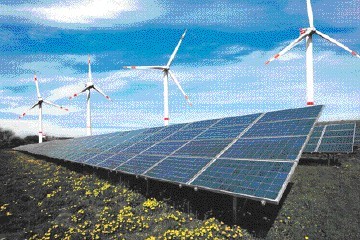
While the word diamond usually conjures up thoughts of expensive rings and show-stopping necklaces, we at GE have other ideas. Deep inside GE’s Global Research Center, our scientists have been developing a revolutionary new material, which we anticipate will have extraordinary benefits for the solar industry.
This material, Silicon Carbide (SiC), a synthetically produced crystalline compound of silicon and carbon, was first discovered in an attempt to produce artificial diamonds and shares many of its properties, including strength and resistance to high temperatures. These diamond-like features, combined with electrical conductivity, make the material the ideal substitute for traditional semiconductors, giving it the potential to transform the power conversion methods used today.
GE’s LV5+ Series Solar Inverter Unveils Enhanced Efficiency
While the industry is working towards driving down solar’s levelized cost of electricity (LCOE) and to achieve grid parity with other sources of energy generation, power conversion efficiency is emerging as an “invisible fuel” to provide a cost-effective means to achieve just that as well as much-desired higher energy yields.
SiC is one enabler to achieve that. SiC is better suited for use at higher voltages, simplifying power converter topologies and increasing reliability thanks to lower parts count. Due to its lower losses, SiC can achieve up to twice the power density compared to silicon designs. This can increase the amount of energy produced per year in a smaller footprint than today’s silicone-based inverters.
Fewer losses also mean that the inverter doesn’t generate as much heat, therefore allowing for an air-cooled system. With a filter-less air-to-air heat-exchanger system, the LV5+ Solar Inverter enjoys a simpler design and high reliability. This can translate into OPEX savings of approximately $300,000[1] over the lifetime of a 100-megawatt (MW) power plant.
Yet, the most powerful benefit of using the material in the solar inverter application is that it increases power conversion efficiency for utility-scale, multi-megawatt solar power inverters. Many of today’s solar inverters achieve just over 98 percent efficiency, based on the EU “weighted” efficiency calculation standard. However, GE’s Power Conversion business’ LV5+ Solar Inverter is expected to provide an additional boost in power conversion efficiency, reaching 99 percent EU efficiency.
At first look, this may not seem like much, but taking the U.S. for example, the annual energy production (AEP) increase, thanks to the improved efficiency of SiC, yields over $2.2 million[2] of added value over the lifetime of a 100-MW solar plant, which could be enough to power 170 extra households per year. On average, if a 100-MW solar plant had inverters that were just 1 percent more efficient, this could result in over $2.5 million additional energy generation2 over the plant’s lifetime.
Solar inverter efficiency of 99 percent, compared to the current industry standard, means that a solar inverter of the same power capacity will be able to convert more solar power and thus more renewable electricity is produced, helping advance solar towards a lower LCOE.
From lab to products
GE has a long history of innovation in the field of semiconductors. Having first invented and commercialized the silicon-controlled rectifier in 1957, GE went on to develop the Triac, a silicon-controlled rectifier, which allowed electricity to be conducted in both directions. By 1979, GE had gone one step further and created an insulated-gate bipolar transistor (IGBT), a three-terminal power semiconductor device, which is used in almost all utility-scale renewable energy applications.
After many years of development and research, we are finally reaching the next significant milestone throughout the history of power electronics development. Today, GE scientists are using it to build inverters that can super efficiently transform direct current (DC) generated by solar panels into alternating current (AC), which eventually flows from your wall outlet.
A 2-MW SiC solar inverter skid demonstrator from GE’s Power Conversion business left the factory in June and has been installed in the United States, ready to power the local area.
Renewable energy production is now more competitive than ever, as technological and efficiency improvements continue to drive down LCOE. With technologies such as SiC converters now coming into play, this can only continue to make cleaner energy and a greener future a reality for all.
Vincent Schellings is a product line leader for power electronics, GE Power Conversion.
